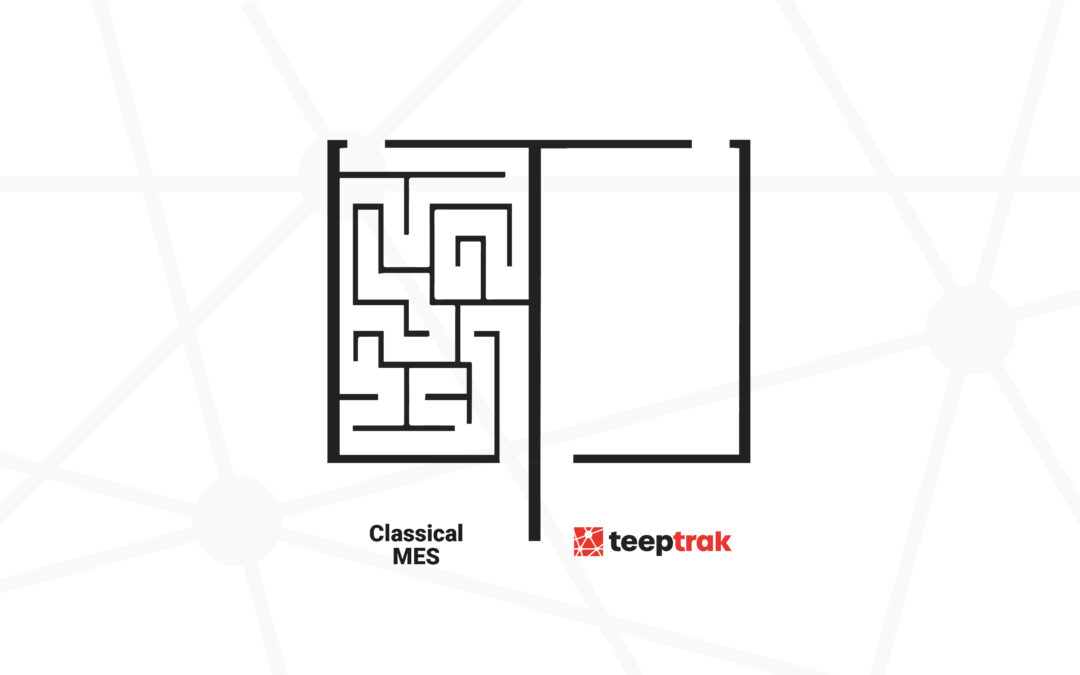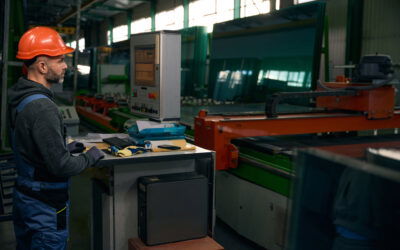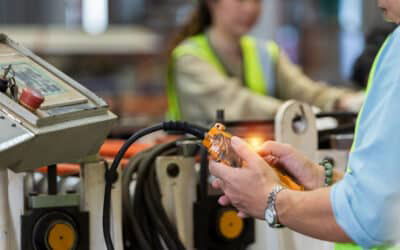Which technology is best: MES or expert bricks?
MES (Manufacturing Execution Systems) are an important link in the chain of production performance monitoring. They provide the link between the sensors, actuators and PLCs that are essential for feeding back production information, and the ERP systems that have become essential for global production management over the last century. They are far more comprehensive than the expert bricks.
But behind the acronym MES lies a wide variety of systems, each with different sizes and functionalities. Most are on such a scale that they replace ERP systems and quickly become veritable ‘gas factory’ systems, capable of communicating only with a limited number of automated production machines.
In a context of technological proliferation, this observation is leading a large number of manufacturers to take an interest in ‘expert bricks’, less complete but more competitive and ergonomic production monitoring systems that specialise in a limited number of functions provided by the most complete MES.
What is the ESM doing?
The main objective of an MES, or production management system, is to manage production orders in line with actual resources, and to provide feedback to the ERP system on stocks and production. In the 4.0 movement, accurate feedback on the status of resources is a vital ingredient of performance. Some even see MES as the heart of the intelligent factory.
Today, MES is a Swiss army knife with a much broader range of functions. The ISA 95 defined up to 11 functions: Resource management / Production dispatching / Data collection and acquisition / Quality management / Manufacturing process management / Planning and monitoring / Performance analysis / Operations management and scheduling / Documentation management / Labor management / Maintenance management.
MES quickly took its place in the ‘product location, physical movements and batch management’ layer in level 2 of the original CIM (Common Information Model). This layer ensures communication between level 3, which is occupied by CAPM and ERP systems, and level 1, which is occupied by automation and SCADA machine control systems.
Painstaking deployment
The memory of ERP projects is very fresh in the minds of manufacturers, and MES has followed the same path: installations that lasted several months, with development that was sometimes obscure, often cobbled together, and always tedious. When intelligence is reserved for the thinking, decision-making head that is ERP, when we seek to trivialise the muscles that are automation on the shop floor, the MES is left with the dirty job of making it all work ‘for real’ in the factory.
Between field communication with sensors and PLCs and the ongoing inter-compatibility required with ERP-type software, building an MES has become an obstacle course, especially as some functions compete with other software packages in the company.
Even though technological innovation is driving MES suppliers to slash their prices, cost remains a major weakness of these technologies, especially when coupled with the fact that the full range of functions offered in ‘all-in-one’ packages is not ultimately used. The complex integration of this type of system, with its cross-disciplinary and multi-disciplinary functionalities, generally entails its share of additional costs (subsequent to a very high ‘standard’ starting price) to cover the intervention of technicians dedicated to hardware and software configuration and end-user training.
Integration represents an additional headache for MES suppliers when it comes to being able to communicate with older, non-automated machines that are not affected by PLC communication. Very few suppliers are able to meet this challenge, and it is often the most modern machines that are affected by all the MES functions in a workshop.
By the same token, the teams in the field who are least familiar with the new technologies are automatically excluded from the process of setting up and operating MES systems, which will only be operated by a small number of engineers, often more IT-oriented than production-oriented…
At a time when automated systems did not communicate easily with management software, MES provided the necessary configurable interface. The question of their physical integration and end-user training was therefore less of an issue than it is today, and did not run completely counter to a new paradigm: Plug & Play.
When it comes to the new challenges of the factory of the future – flexibility and near-real-time reconfiguration – the current trend is to aim for targeted self-sufficiency objectives that can be achieved very quickly. Hence the advent of expert bricks.
The MES market is set to evolve with the multiplication of expert bricks.
Industry is constantly renewing itself, in its core businesses, its infrastructures and its principles. IT architectures are undergoing radical change: the IOT is entering information systems, automation is spreading, wires are disappearing in favour of radio networks, field buses are being replaced by a new universal fast Ethernet, and the cloud is no longer taboo as some dream of direct flows between customers and production machines. In short, many layers of convoluted interfaces are losing their usefulness, while through-flows are emerging.
The methodological changes are just as remarkable. From a primary need for automation and high-performance planning, industry has moved on to continuous improvement and then agility. The employee is refocused in the system, changing management and man-machine interfaces. Lean is more than ever at the heart of the concerns of all decision-makers: a good solution must include lean management, because trying to implement Lean with traditional directive solutions is a challenge. The role of the operator is also changing: sometimes the only person able to indicate certain elements or guide a decision, his contribution of expertise must be easily integrated into the flow of information.
Based on a highly structured and rational concept of standards, are MES still well adapted? This is the question being asked by many manufacturers, but also by the MES providers themselves, who are increasingly tending to break down their ‘all-in-one’ offering into ‘expert bricks’.
Providing new solutions
Solutions known as ‘MES bricks’ are simply systems that specialise in one or more key areas of MES (performance monitoring, traceability, quality management, OF monitoring, etc.). They belong to the MES world because they are part of the same communication layer between sensors/automats and ERP, but offer a less diverse range of activities, which they nevertheless cover more easily and at lower cost.
The main difference with full MES is the flexibility of implementation they offer. These solutions are generally designed so that they can be implemented in a large number of production situations, rapidly standardising the analysis of equipment, whether old or new, already connected or not. Their aim is to communicate easily with the lower layers (sensors, PLCs, etc.) and higher layers (MES/ERP), using widely available communication technologies (Bluetooth, WIFI, etc.). Integrating these expert components quickly and competitively means that manufacturers can iterate their digitisation plan and avoid time-consuming rollouts, by testing different emerging technologies on a few pilots at very low cost. Then, if the technology is selected, they can connect a limited number of production resources, à la carte.
As far as the use of data is concerned, suppliers of expert bricks have clearly understood the importance of including field teams in the use of production monitoring tools, and are focusing on intuitive programming and data analysis interfaces that can be used on a daily basis by both managers and operators. If the tool is to be used on a daily basis, the operator must remain at the centre of operations, in the real as well as the virtual world.
The contribution of these expert components can be seen in their integration, cost and ease of use, which can be summed up in one key criterion: agility. But not all bricks are created equal, and some of them can make the same mistakes as the most complete MES systems. In terms of integration, for example, it may be impossible to communicate with equipment of any age, because some expert bricks can only retrieve information from machines via PLCs. And in terms of cost, many suppliers offer highly modular solutions in return for very costly custom developments.
TEEPTRAK, the example of the expert brick dedicated to performance monitoring, but not only…
Like other industrial start-ups, TeepTrak started from the realisation that there was a real lack of simple production monitoring tools. The company provides all industrial sectors with a turnkey MES solution based on connected objects for monitoring the performance of any industrial equipment, old or new.
There’s no need for a PLC connection or an automatic link with the plant’s other IT systems: the TeepTrak solution can be integrated into any production area in less than 1 hour, completely externally, and only needs Internet access to communicate with its server and the plant’s other IT systems (MES/ERP).
The aim of the solution is inspired by the Lean philosophy: to identify and restore the root causes of non-performance in a very simple and competitive way. It uses the latest communication technologies (Bluetooth Low Energy, WIFI) to automate machine data feedback (cadence, start/stop status, part count) and links it to non-performance cause data supplied by the operator on a tablet.
All this information can then be viewed on a data consolidation platform, enabling plants to quickly understand the main causes of the non-performance of their industrial resources.
The solution is an example of an ultra-competitive and particularly scalable expert brick, which is uniquely positioned in a specific area of MES – performance monitoring – and manages to tread on the toes of giants whose names we won’t mention here, but who will have no trouble recognising themselves.
But we have also developed other building blocks, all of which live in an ecosystem: ProcessTrak for monitoring physical values, PaceTrak for manual tasks and QualTrak for quality monitoring.
Our solutions have been deployed on a large scale in more than 150 plants since 2016, in the automotive, agri-food, rail, electronics and aerospace industries.





0 Comments